Chapter 3
What we see in connecting lives.
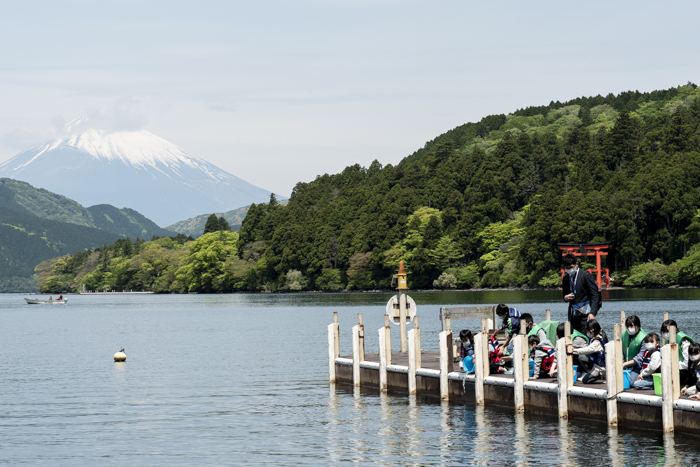
Eleven little ones, led by their older brothers and sisters, were holding buckets with tense expressions on their faces. Sitting side by side on the pier, the older brothers look at the eleven of them as if they are leaning against each other from behind. They then joined their voices together, but their cute voices drifted away in the green wind, perhaps from embarrassment and nervousness. The teacher, who couldn’t bear to look at them, smiles and says, “Be a little more cheerful”. The parentswatching from the lakeshore and the neighbouring kindergartens – small friends who had probably been playing together until recently – cheered for the children and said “Ganbareta”. The children, seeing this, now shouted with more vigour.
Grow up big!”
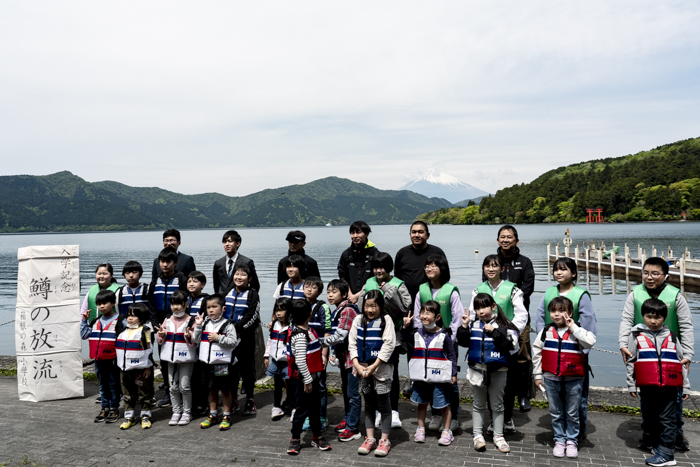
Thirteen sixth-graders (one absent) and 11 new students from Hakone no Mori Primary School, with members of the Lake Ashinoko Fishery Cooperative and teachers looking after them.
When the fry were then gently released into the lake from the bucket at hand, the children were given a warm round of applause as they were relieved of their tension.
The children anxiously followed the fish after they had completed their major role. The released small fish swarmed and migrated around the shallow lakeshore as if to say goodbye.
‘Why don’t you go swimming?’
Mr Tatsuya Fukui, head of the Lake Ashinoko Fisheries Cooperative, responds gently to such comments.
‘Fish that have grown up in fishponds are afraid of the deep places where they can’t see the bottom. Fish don’t like to look down, and I think they instinctively know that bigger fish will attack from the deep.”
Under a clear sky, Lake Ashi is surrounded by a brocade-like forest with Mount Fuji floating in the distance and fresh greenery. The small fish swimming fearlessly in the wide lake reminded me of children who have just stepped out into a new world.
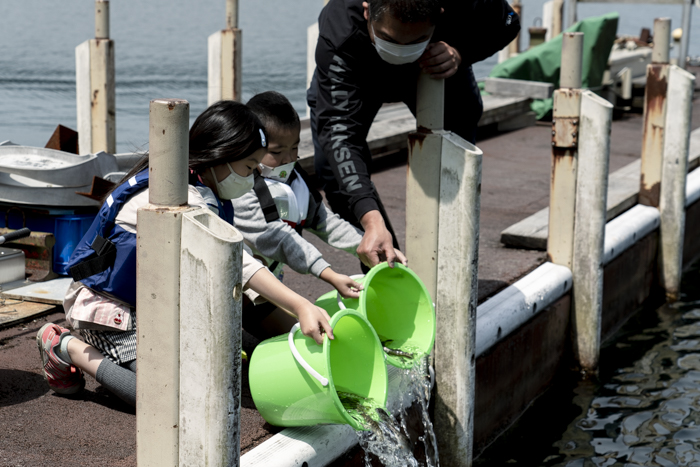
First year students releasing buckets of fry into the lake. A little nervous. ......
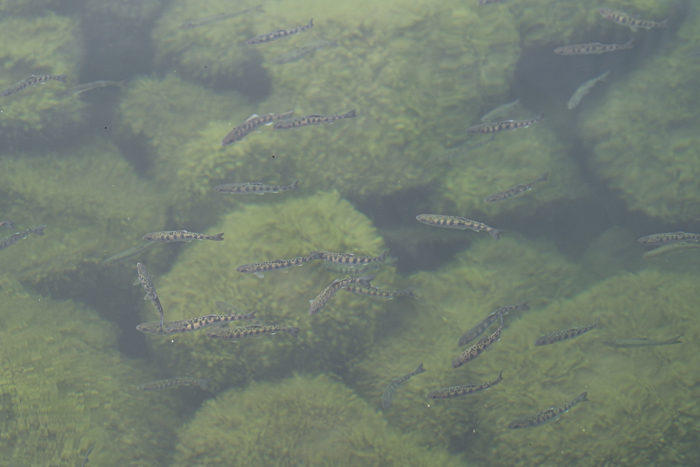
The fry are released into the lake and remain in the shallows for a while, perhaps confused by their first time on the water.
In May last year, the Hakone-no-mori Primary School in Hakone Town, Kanagawa Prefecture, organised an annual event, the ‘Entrance Commemoration Trout Release’, in cooperation with the Lake Ashino Fishery Cooperative.
The first-year students of Hakone-no-mori Primary School have a long history of releasing fish in commemoration of their entrance into the school. 40 years ago, when the school was still called Hakone Primary School before the primary schools were merged, when Mr Fukui was a first-year student. Union member Yosuke Yuki also has vivid memories of the event.
When we were kids, we would go straight to the lake after the entrance ceremony to release the fish.”
There was a period after that when it was not held for a while, but 10 years ago, it was none other than Ms Fukui and Mr Yuki who revived it.
‘I couldn’t stand still when I saw a report that children in Tokyo had been asked to draw tuna and they drew the state of the fence.’
Then they both think. If we are going to revive the commemorative admission release, we want to do something meaningful and rooted in Lake Ashi.
And so we decided to release the cyprinids.”
Their childhood releases were rainbow trout and carp. More than these fish, the cyprinid trout has a close connection with Lake Ashinoko.
The lake’s history is second only to that of the wakasagi, and the first trout were released into the lake in 1928. Above all, we take the eggs from fish that have grown up here, hatch them and raise them.”
The Lake Ashinoko Fisheries Cooperative handles 12 species of fish, but only wakasagi and dace are hatched from eggs taken from parent fish from their own lakes.
Lake Ashi is inhabited by several species of trout under the care of the fisheries cooperative, but the prolific rainbow trout and brown trout do not spawn at the same time, making it difficult to obtain eggs and make it a viable business. The cherry trout (landlocked salmon) and satsuki trout (amago), which, like the hime-masu, spawn only once in their lifetime, have been hatched and released into the lake since last year, and there are high hopes for their future.
The land-locked form of the sockeye salmon, the hyemasu salmon, is born in rivers, grows up in lakes and migrates down to the sea. In Japan, sockeye salmon are naturally distributed only in Lake Akan and Lake Chimikeppu in Hokkaido, and their life has been preserved by human intervention in Lake Ashi.
‘Lake Ashinoko has been in the aquaculture business for a long time, but it wasn’t until 1993, when the current Hirukawa fish farm was completed, that it took on its current form.’
After three years as adults, the cyprinids return in October to spawn in the Hiru River, which flows through the fish farm where they were born, but the Hiru River, with its small river size, is not conducive to spawning.
For the past ten years, we have been giving fifth-graders from Hakone no Mori Primary School a chance to experience this process.
The following spring, the fifth-year students who have undertaken the egg-collecting exercise release the young fish that have hatched from the eggs they have collected into the lake together with the new first-year students. Three years later, they return as adults – a cycle has been established.
‘The fifth-graders will be given a knife and asked to cut up a live cyprinid trout.’
They accept the risk of carrying blades, disregarding efficiency and fertilisation rates, because they believe it will help the community.
‘Last year, however, the run wasn’t great and the number of eggs taken was low. Also, the egg situation was not good. …… It seems that the situation was the same in Hokkaido, so it was a difficult year for pike all over the country.”
Of course, there were some healthy brown trout, but they were slower growing than in previous years and were not ready to be released.
‘I don’t think they will grow up safely if we release them into the lake as they are. Also, there is no point in releasing them just for form’s sake, so we explained the situation to the children and decided to have them release satsuki trout (amago) this year.”
The satsuki trout transferred to the tank weighed about 15 kg. The first-year students were excited to see the beautiful fish, which was coloured with blue parr marks and vermilion dots. The sixth-graders, who had experienced egg collection, were promised that the damsels would be released at the appropriate time by responsible members of the fisheries cooperative. The students were then carefully explained the difficulties involved in handling life.
90% of Lake Ashi’s cyprinids are male. Even if they are born as females, their chromosomes remain female in the warmer Lake Ashi water temperatures, and they will turn into males. If global warming continues in the future, not only Lake Ashi, but also the cyprinid trout themselves may become extinct.
After the release, Mr Fukui then spoke to the children.
‘Lake Ashi is very clean now, but when I was a child, the lake was very dirty and it was difficult for fish to live here. The adults realised this and revived it by building a sewage system and creating an environment where living creatures could thrive.”
Wilderness is beautiful. We who have moved away from it regard such wildness as supreme, but nature protected by human hands – the will to protect it even at the cost of losing something – is just as precious.
As you graduate from primary school, go on to junior high school, high school and adulthood, some of you will probably leave Hakone. But please remember that there is a lake like this in your home town.”

Tatsuya Fukui, head of the Lake Ashinoko Fisheries Cooperative Association, with children discussing their impressions after releasing the fish.
Love Hakone, be clever, kind and strong.
The educational goals of the three primary schools in Hakone town were shared with us by first-year teacher Tokuyuki Kato, who is in charge of the first grade.
We call it ‘Hako-iku’, which means ‘box education’, and our goal is for students to be able to talk about the good qualities of Hakone and communicate those qualities to others.
The release of the fish on this day is part of this, and is incorporated into the first-year students’ ‘Life Studies’ and the sixth-year students’ ‘Integrated Learning Time’. Other activities include making marquetry and handmade sandals and walking along the old Tokaido Highway in them.
‘I am from the town of Yugawara, but when I became an adult, I realised how little I knew about my town. I think that knowing the town you live in correctly from a young age will help you in the future. I feel that the feeling of having a local town that you love will protect your children.”
However, it is both time-consuming and risky. …… When I say so, Tomoyuki Kubodera, a teacher in the teaching staff, continues with a laugh: ‘That’s right.
But if we cut back on that, we would be limited in what we could do. With so many people in the community willing to help, I wanted to reaffirm my desire to let the children experience it.”
And the experience of life involves a wide range of learning. Dr Kubodera continues.
‘The little fish being eaten by the big fish.’ The significance of human intervention in what would otherwise be a natural process. There is a connection to life there, and I think that’s an experience that goes beyond science and moral learning.”
If adults realise the value of this, even if it is beyond risk, we want children to know what it means and learn from various aspects – even if it is beyond risk.
‘And there are adults who work hard to protect Lake Ashi and clean water for the community. If they realise that, I think it will be a learning experience that goes beyond one subject.”
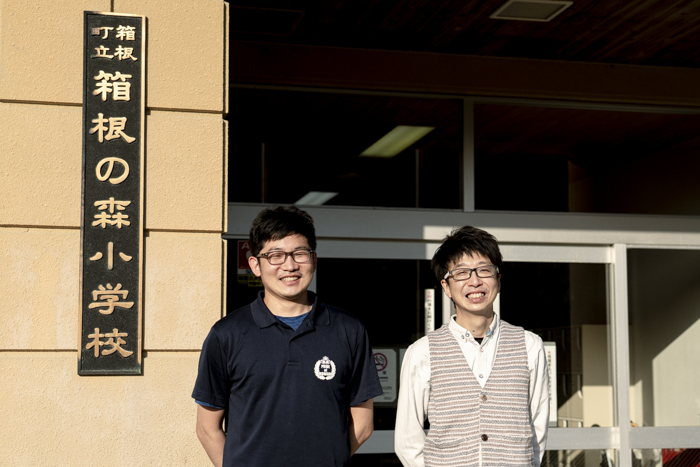
Dr Noriyuki Kato (left) and Dr Tomoyuki Kubodera, who spoke about 'box education' with great enthusiasm.
Mr Fukui and Mr Yuki of the fishing cooperative vividly remember the entrance release, and the excitement of the event has led them to this work.
‘When I started working part-time at the fishing cooperative at the end of my teenage years, I sometimes helped with the fishing classes that the senior staff would run for the children. But that was a pain in the ass. …… But at my age, I think, I was grateful for that. It’s what the seniors in the fishing cooperative have done and what we are allowed to experience. It’s something I’m rather eager to do now, though.”
Mr Yuki laughs merrily.
‘Wow, I don’t remember that at all ……’
Laughing bitterly at this is Mr Kaneko Mori, a classmate of Mr Yuki’s and the person in charge of coordinating this interview. Mr Kaneko was born in Hakone, grew up in Tokyo and eventually spread his wings to the world. He has lived abroad and travelled the world’s fields. Then, when he turned 30, he returned to Hakone and now works as a mountaineering guide, sharing the wonders of local nature and culture.
Seeing this makes me think about what it means to bring up children and to live in the community as an adult. What can I do now?
Children are like seeds covered with cotton wool. Where they go will be decided by themselves or by the wind of the moment. Wherever they blossom, I can’t help but wish that there were lakes, oceans and mountains in their bosoms, and that fish were swimming in them.
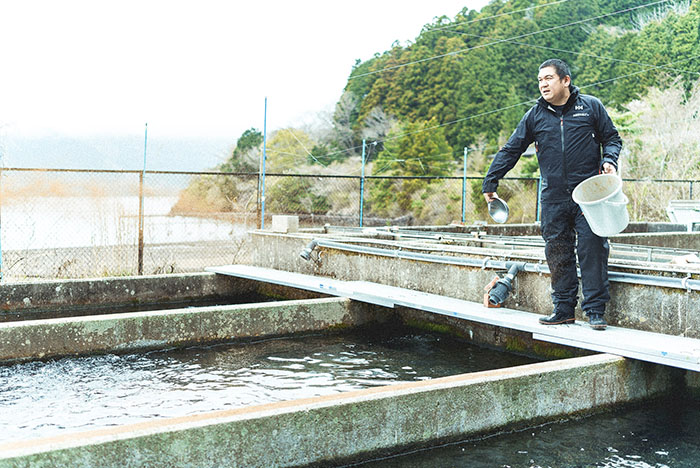
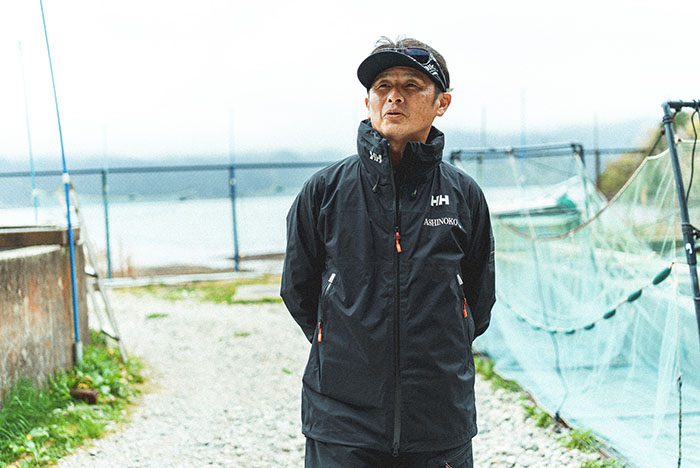
What can we do as a fishing cooperative and as adults who love our local community? …… With these thoughts in mind, Yosuke Yuki (above) and Tatsuya Fukui (below) are still working hard today.
Text by Koki Aso
Photo by Masaya Kudaka, Shin Kaneko
Translation = Asaka Barsley
Direction by Shin Kaneko
Interview supported by Lake Ashi Fishery Cooperative Association, Hakone-no-mori Primary School



